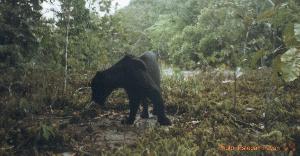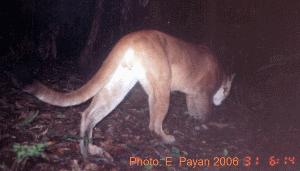Esteban Payan
My project aims to evaluate and compare differential mammal abundances in a protected (ANP) and an unprotected site (CRV) with differential hunting levels by several human cultural groups in Colombian Amazonia, focusing on wild cats and their prey.

Black jaguar in Caatinga habitat, Amazonas, Colombia.
Like most top carnivores, jaguars (Panthera onca), pumas (Puma concolor) and ocelots (Leopardus pardalis) are threatened by habitat loss, hunting, and prey competition with humans. The Colombian Amazon (403,000 km2) is the stronghold for these species in the country, but only 10 % is legally protected. This is insufficient to ensure their long term survival, due to their large area requirements, thus the populations in unprotected areas are key for their survival.

Puma (Puma concolor). In eight months of camera trapping pumas only appeared in pictures from two separate weeks.
The Amazon basin is an area one of the most affected by the so called “bush meat crisis” and the levels of hunting in the Colombian region remain unchecked.
The effects of human hunting are evaluated through structured interviews in with hunters, weekly hunting harvest records in villages and through monitoring wildlife and levels of disturbance using a combination of camera trapping and spoor surveys. Jaguar and ocelot are recognized from their coat pattern and thus camera trapping data from these species is evaluated by capture-recapture statistics to produce abundance and density estimates. Unmarked carnivores and prey species are evaluated by Relative Abundance Indexes (RAIs) and compared between sites and habitats.
Spoor surveys are analysed by relative abundance indexes based on sign per km sampled. Hunting harvests are evaluated against a sustainable harvest model for Neotropical wildlife proposed by Robinson and Redford (1991). Data from both sites are compared and associated to differing area protection levels and human resource extraction and exploitation impact. Results will be the first estimates of wild cat abundance for Colombia and one of the few from the Amazon basin, which will contribute to understanding the ecology of these secretive cats in rainforests. Data from prey species in areas with different levels of protection and facing different hunting threats posed from different ethnic groups will describe the scenario faced by wild cat populations in the Amazon today. This data will feed into an assessment towards the potential for unprotected areas to sustain cat populations in the face of increasing immigration into the Amazon.
The assessment of the sustainability of hunting of each cultural group will help to define management and conservation decisions and actions towards securing the continuation of this protein source for humans without degrading biodiversity levels. Finally, results will offer baseline population data for future monitoring actions and to initiate conservation sensitization programs and management for conservation.